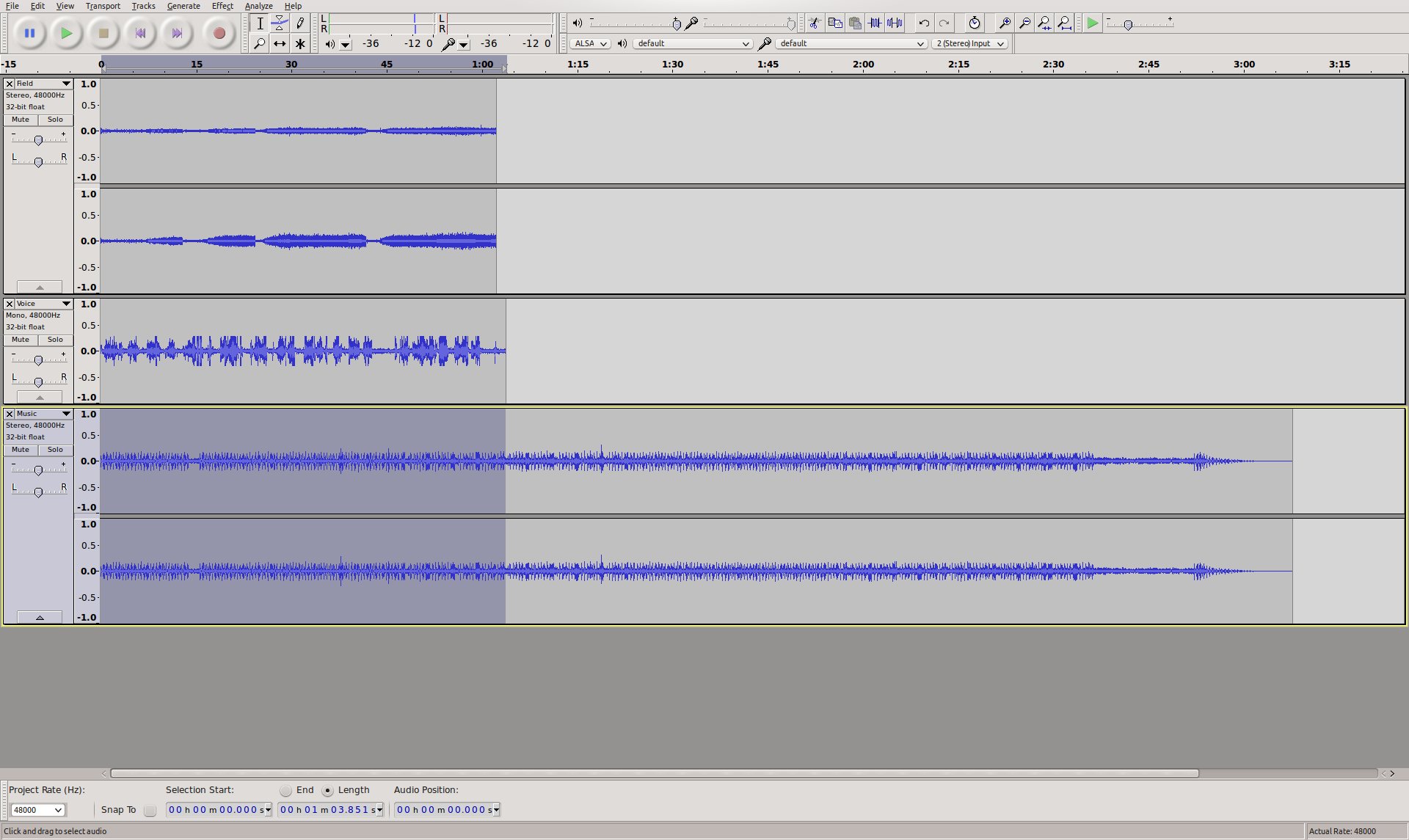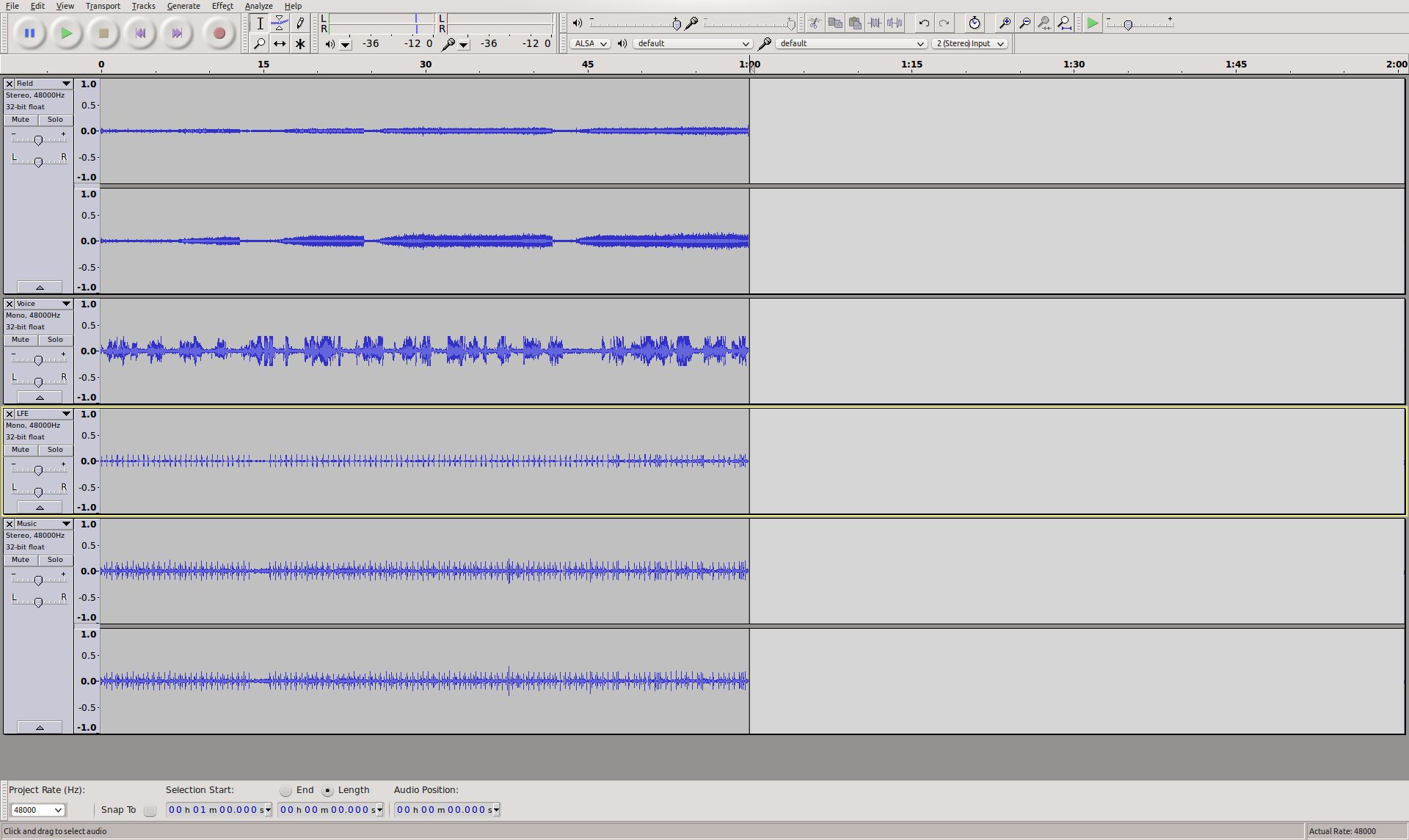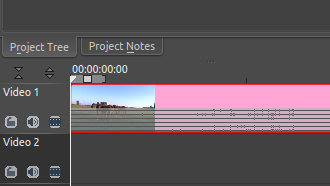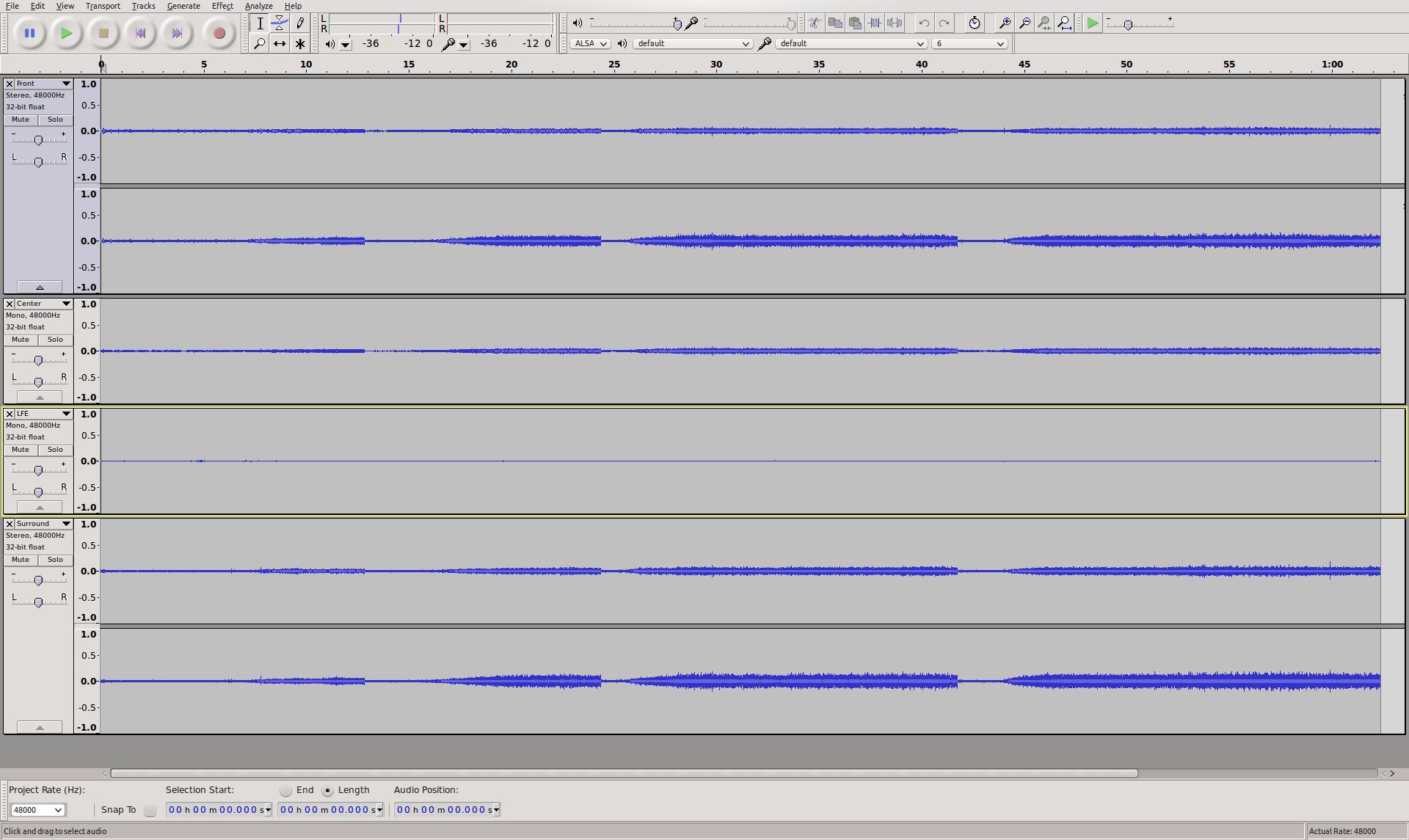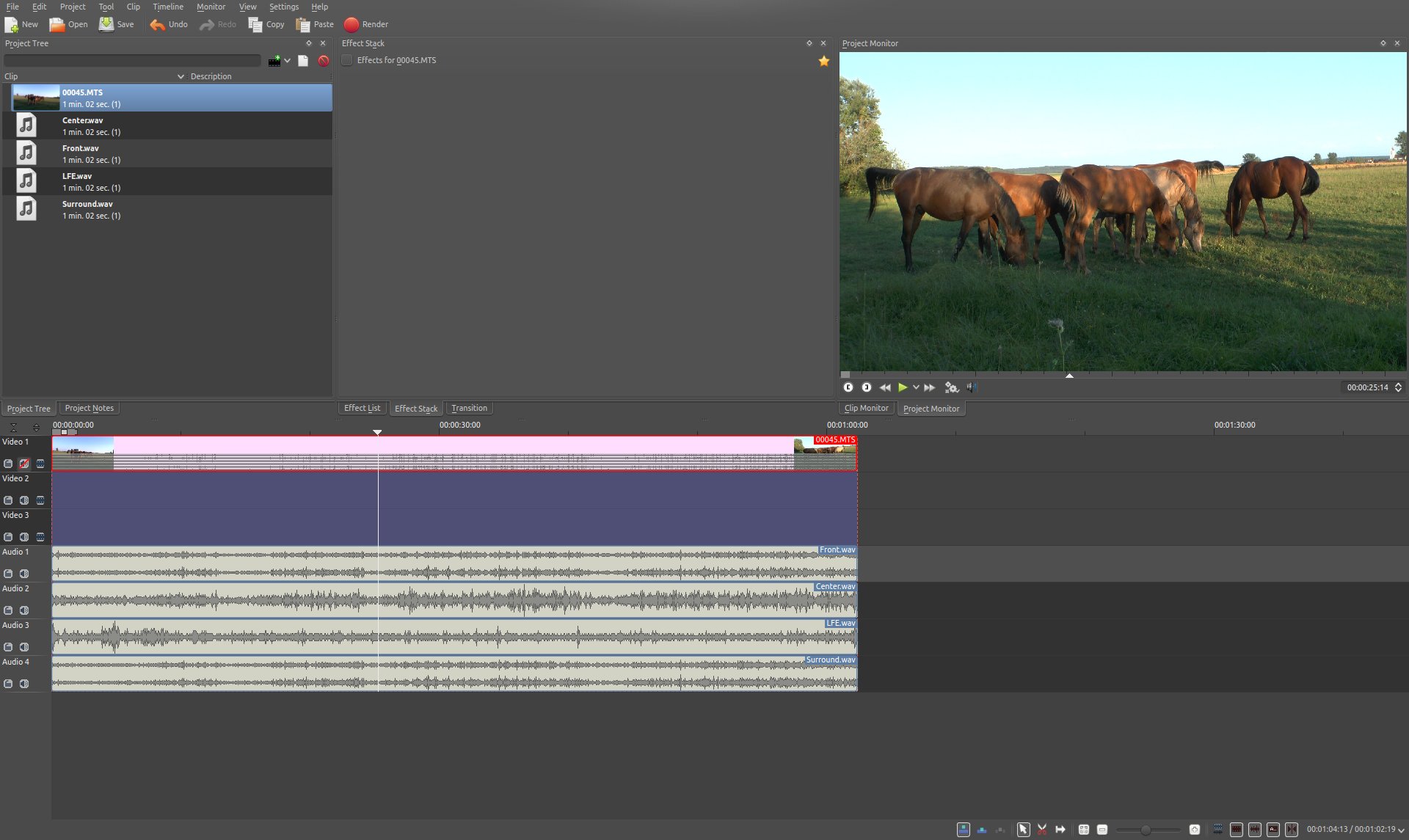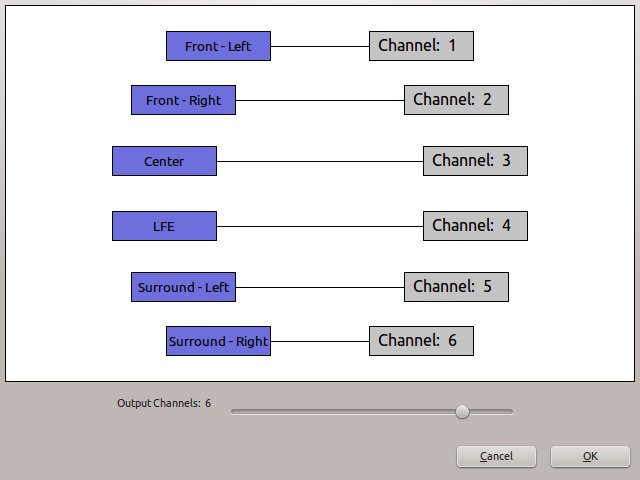Kdenlive/Підручник/Корисні відомості/Об'ємний звук
Редагування об'ємного звуку за допомогою Kdenlive
На момент написання цього підручника у Kdenlive було передбачено підтримку обробки проєктів, у яких міститься лише стереозвук. У програмі не було передбачено можливості обробки більшої кількості каналів або явної прив'язки каналів у оброблених звукових даних. З метою редагування та створення об'ємного звуку слід було виконати декілька кроків вручну, зокрема з використанням сторонніх інструментів.
У нашому підручнику для прикладу використано 6-канальний об'ємний звук формату 5.1.
Зовнішні інструменти
- Audacity — вільна програма для редагування і запису звуку
- avconv — програма для перетворення відео та звукових даних
Створення об'ємного звуку
У цьому підручнику описано один із можливих обхідних маневрів з використанням Audacity для створення та обробки звукової доріжки об'ємного звуку 5.1, який можна додати до відео, обробленого за допомогою Kdenlive.
Створення і редагування об'ємного звуку за допомогою Audacity
У наведеному нижче прикладі використано простий об'ємний звук 5.1:
- Якийсь оригінальний польовий запис спереду (стерео)
- Якісь голосові дані (спереду) по центру (моно)
- Якась музика ззаду (стерео)
Якщо, як у нашому прикладі, якусь із частин записаного матеріалу з відеокліпу слід використати для створення доріжки об'ємного звуку, її можна без проблем видобути за допомогою Kdenlive, скориставшись пунктом контекстного меню кліпу. У результаті буде створено файл звукових даних WAV у тій самій теці, де зберігається файл відеокліпу.
Звукові кліпи, які використано у цьому прикладі:
- Field.wav (стерео) для передніх лівого і правого каналів
- Voice.wav (моно) для центрального каналу
- Music.mp3 (стерео) для об'ємного звуку лівого і правого каналів (ззаду)
У новому проєкті Audacity
їх можна імпортувати у вказаному вище порядку за допомогою пункту меню . Проєкт після цього має виглядати десь так:
Прив'язка каналів для об'ємного звуку у форматі 5.1 є такою:
- 1 — передній лівий
- 2 — передній правий
- 3 — центральний
- 4 — низькочастотні ефекти (LFE)
- 5 — об'ємний лівий
- 6 — об'ємний правий
The stereo track "Field" can now be mapped to Front L+R, "Voice" to Center and "Music" to Surround L+R. There is just one problem: the Surround (rear) speakers of a surround speaker system are usually "small" and not able to reproduce low frequencies. So it would be necessary to map the low frequency range of the "Music" track to the LFE channel, otherwise the music might sound a little "thin".
To do this, the "Music" track can simply be duplicated with after selecting it, and then from the context menu of the third track. Then one of the two mono tracks can be deleted; the other one can be renamed to "LFE".
Тепер можна скористатися ефектом «Еквалайзер…» для обрізання частот понад приблизно 100 Гц з доріжки «LFE», і навпаки, відрізанням усіх частот, які є нижчими за приблизно 100 Гц на доріжці «Музика».
What remains for now is to make sure that the surround sound track has the same length as the video track it should be added to. The video track used in this example has a length of 1:00 minute, so the lengths of the audio tracks in Audacity are adjusted accordingly:
Проєкт Audacity після цього має виглядати десь так:
The next thing to do is to export the project to a multichannel 5.1 surround sound audio file. The format used here is AC-3 (Dolby Digital).
Before exporting, Audacity needs to be configured to allow exporting to a multichannel audio file: In , under , select "Use custom mix (for example to export a 5.1 multichannel file)".
Проєкт тепер можна експортувати до файла звукових даних у форматі об'ємного звуку 5.1:
- Виберіть пункт меню
- Вкажіть у полі Назва назву і виберіть формат файли AC3 (FFmpeg)
- Натисніть кнопку Параметри... і виберіть 512 кбіт/c у полі Бітова швидкість
The "Advanced Mixing Options" dialog should show up. The number of "Output Channels" should be 6 and the channel mapping should already be correct:
The result of the export should be an *.ac3 file which is playable with e.g. VLC or Dragon Player.
Мікшування відео та звуку
The final step is to add the surround sound audio track to the video track, assuming the video was rendered without audio.
Assuming the video track was rendered to "Video.mkv" and the surround sound was exported to "5.1.ac3" the command to mux both to "Video-5.1.mkv" with avconv would be:
avconv -i Video.mkv -i 5.1.ac3 -c copy -map 0:0 -map 1:0 Video-5.1.mkv
The result should be an MKV video containing a Dolby Digital 5.1 surround sound audio track.
Редагування наявних даних об'ємного звуку
When adding a clip with more than two channels to a project, Kdenlive creates an audio thumbnail that correctly shows all audio channels:
The clip can be edited and (audio) effects applied to it, and all appears to work just fine - but once rendering the project, it turns out that the audio track in the resulting video file is 2 channels (stereo) only.
За допомогою наведених нижче кроків можна вручну обійти цю проблему.
Видобування і відокремлення звукової доріжки
The first step is to extract the audio track from the video clip. This can be done in Kdenlive with from the context menu of the clip. This creates a WAV audio file in the same folder as where the video clip is located.
The extracted WAV audio file can then be opened in Audacity, it should show all 6 channels, these are:
- 1 — передній лівий
- 2 — передній правий
- 3 — центральний
- 4 — низькочастотні ефекти (LFE)
- 5 — об'ємний лівий
- 6 — об'ємний правий
Ідея тепер полягає у тому, щоб розділити об'ємний звук на чотири окремих (стерео/моно) звукових файли, з якими може працювати Kdenlive:
- Передній (стерео)
- Центральний (моно)
- LFE (моно)
- Об'ємний (стерео)
First, Audacity needs to be configured to not always export to stereo audio files: In , under , select "Use custom mix (for example to export a 5.1 multichannel file)".
Now, tracks 1+2 and 5+6 should be turned into stereo tracks by choosing from the context menu of the 1st and the 5th track, respectively. This should result in 4 tracks, two stereo and two mono.
Next, the 4 tracks should be renamed to "Front", "Center", "LFE" and "Surround" starting from the top, using from the context menu of each track.
Тепер доріжки виглядатимуть так:
After all this hard work, exporting the four tracks to four separate audio files is easy with . Use "WAV" as "Export format", the rest of the settings should already be okay: "Split files based on: Tracks" and "Name files: Using Label/Track name".
The "Edit metadata" dialog might pop up for each track. It is fine to just say "OK". At the end there should be a confirmation dialog and four audio files should have been exported: "Front.wav", "Center.wav", "LFE.wav" and "Surround.wav".
Імпортування звукових доріжок до Kdenlive
The previously created audio files can now be added to the Kdenlive project using .
SInce there are only two audio tracks in a project by default, it is necessary to add two more using before adding the four audio tracks to the timeline.
The next thing to do is to group the four audio tracks with the video clip by selecting all of them and then choosing .
Тепер проєкт Kdenlive має бути готовим до звичайного редагування, зокрема вирізання клпів та додавання ефектів. Проєкт має виглядати якось так:
Обробка даних проєкту
Since it is not possible to render the project with a surround sound audio track, some manual steps are necessary to work around this.
First, the video track needs to be rendered without audio. This is simply done by rendering the project as it would normally be done, but without audio, by deselecting the "Export audio" checkbox.
Then, each of the four surround sound audio tracks "Front.wav", "Center.wav", "LFE.wav" and "Surround.wav" needs to be rendered into a separate audio file. For each of them, do the following:
- Вимкніть усі інші звукові доріжки
- Вкажіть відповідну назву файла у полі Вихідний файл
- Виберіть «Лише звук» як «Призначення»
- Виберіть профіль «WAV 48000 кГц»
- Не забудьте позначити пункт «Експортувати звукові дані»
Компонування звукового файла із об'ємним звуком
Now the separate audio tracks rendered by Kdenlive need to be "merged" into a single multichannel 5.1 surround sound audio file. This is again done in Audacity:
- Імпортуйте «Front.wav», «Center.wav», «LFE.wav» та «Surround.wav» (саме у цьому порядку!) за допомогою пункту меню
"Center" and "LFE" are now stereo, which is not what is needed. This can be fixed by selecting from the context menu of each track, and deleting one of the two resulting mono tracks.
Врешті, у проєкті Audacity має з'явитися чотири доріжки:
- Передній (стерео)
- Центральний (моно)
- LFE (моно)
- Об'ємний (стерео)
Тепер проєкт можна експортувати до файла звукових даних із об'ємним звуком 5.1:
- Виберіть пункт менюt
- Вкажіть у полі Назва назву і виберіть формат файли AC3 (FFmpeg)
- Натисніть кнопку Параметри... і виберіть 512 кбіт/c у полі Бітова швидкість
The Advanced Mixing Options dialog should show up. The number of Output Channels should be 6 and the channel mapping should already be correct:
У результаті експортування має бути створено файл *.ac3, який можна відтворити, наприклад, VLC або Програвача Dragon.
Мікшування відео і звуку
Since video and audio was rendered separately, both need to be multiplexed into a single file containing both the video and audio stream.
Assuming the video track was rendered to "Video.mkv" and the surround sound was exported to "5.1.ac3", the command to mux both to "Video-5.1.mkv" with avconv would be:
avconv -i Video.mkv -i 5.1.ac3 -c copy -map 0:0 -map 1:0 Video-5.1.mkv
У результаті має бути створено відео у форматі MKV, який міститиме звукову доріжку із об'ємним звуком Dolby Digital 5.1.


